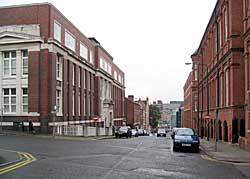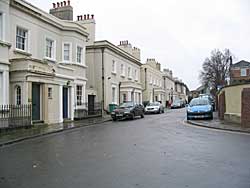< Previous | Contents | Next >
Park Row

View down Park Row (A Nicholson, 2004).
Park Row is a thoroughfare of very considerable interest for it occupies the site of the ditch which in ancient times protected the outer face of the town walls of Nottingham. We saw how this wall came to be erected when we were considering the small fragment of it which still remains in White Cow Yard. The ditch which protected the outer face must have been of considerable size and has been frequently cut through of recent years during the progress of building operations. In the Park Row district it appears to have been cut out of the solid rock with its outer edge overhanging a little, so as to make it difficult to scale. Its depth is indicated by the area just east of the Cripples' Guild (number 17a, Park Row). It was filled up in 1777 and there are indications that in order to ease the gradient of the upper part of Park Row which was made at that time, the hollow round about its junction with Circus Street was carried on arches. In 1925 a very considerable section of the ancient wall was discovered in excavating for the Cripples' Guild and as it was found impossible to preserve this relic, a portion of it was taken down and carefully re-built for preservation in the garden of number 15 Park Valley. Careful drawings and measurements were made and an account by Mr. Heazell was published in the 1925 volume of the Thoroton Society's Transactions. But although the road was made into a thoroughfare about 1797 it was still extremely congested and rural in its nature. As a matter of fact it was called the Butt Dykes and in it archery seems to have been practised in early days. Down to 1866 it was only about five yards wide in the portion between Chapel Bar and Circus Street. On the east side it had a narrow causeway and on the west side there was a row of posts to protect the property. However, all this was altered about 1866. The lower end was widened and a decent road was made right through to the Rope-walk with its gradient eased as we have already seen. There is a good deal of interest still left in this thoroughfare. Down to 1750 there was a large orchard between Park Row and Mount Street whose upper end was bounded by the Baptist burial ground. Of this land a portion seems to have been let on a 999 year building lease in 1724 to the parish of St. Peter's for the erection of a Poor House. This institution stood at the corner of Park Row and Chapel Bar and its site is to a large extent absorbed in the present roadway of Chapel Bar. In 1815, St. Nicholas's Parish erected their workhouse in this neighbourhood about where Messrs. Woolley's premises now stand and transferred their inmates from Jessamine Cottages thither.
This house is very interesting for it contains a good deal of old work, for example, the two great 16th century Gothic windows above the shop windows have rather a romantic story. It appears that the present house was being erected sometime about 1834 by a private individual who had bought the site after the workhouse was abandoned. Just before this a great fire had occurred in London which had so seriously damaged the old Houses of Parliament that it was decided to clear the debris away and erect entirely new buildings. The old building material was sold for what it would fetch and certain portions of it, including these windows were purchased by the gentleman who was building this house and included in his new erection so that one has the pleasure each time one goes up and down Park Row of looking at windows which in ancient times must have illuminated the home of the mother of Parliaments. This house and the one adjoining it were occupied as barracks by a rifle brigade during the stormy days of 1840 and later on a Line Regiment was billeted there.
St. Thomas's Church which is now closed as a place of worship was erected by a certain Mr. Mercer and it was used as a meetingplace for "the Free and Independent Methodists." In 1875 it was converted into an Episcopal church. Its chancel and aisles were added and it was decorated by its churchwarden, Mr. G. Sparrow.

Park Terrace (A Nicholson, 2004).
At the upper end of Park Row are memories of two reservoirs. On the north side, where one of the departments of the hospital now stands, was the old reservoir made out of a portion of the town ditch leased to the old Water Company in 1695 and used as we saw when we studied the ancient water supply of the town. On the other side of the road, where the new out-patient department now stands, was until 1925 the reservoir which has already been mentioned.
There is nothing of very great interest in the streets immediately off Park Row, those to the north are filled with the architecture of the late Mr. T. C. Hine, which although perhaps not in accordance with modern ideas has a certain dignity and interest of its own.
